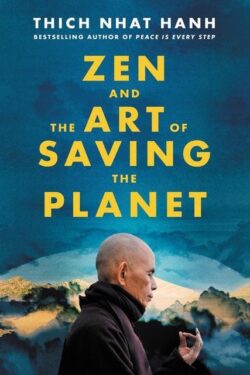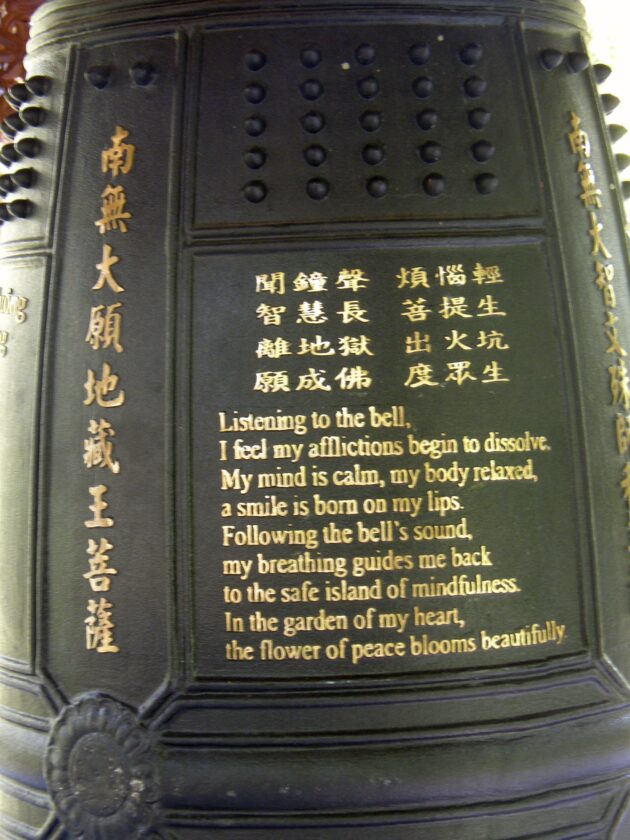
Zen and the Art of Saving the Planet
by Thich Nhat Hanh. New York: HarperOne, 336 pp., $22.39.
Renowned Zen Buddhist monk Thich Nhat Hanh tasked a monastic disciple of his, a decade or so ago, with compiling his various writings, Buddhist dharma talks and informal dialogues from over the years. That project has finally come to fruition with the new release of this well-edited book by a major international publisher, and its potent message of reconciling inner peace with the need for urgent physical action arrives not a moment too soon.
Little has changed in the world since the idea for this book was first set in motion, and yet much has changed for the worst: political and economic instability, extreme climate change disasters, racial injustice and a deadly pandemic that leaves no neighborhood on Earth untouched, to name a few. The author himself has also come face to face with the reality of old age.
Zen and the Art of Saving the Planet takes many of the greatest hits of Nhat Hanh and presents them as a single, running discourse on the perilous state of the world and how the Vietnamese Zen sect of Buddhism with which Nhat Hanh is affiliated — especially the socially active brand of “engaged Buddhism” he made popular in both the East and West — offers a viable road out of this human-created morass.
“The way out is in,” as Nhat Hanh says, and in this book meditation and mindfulness are once again at the heart of the healing path. Meditating, according to Nhat Hanh, is not only what happens when we are being still and silent, but also while we are walking, eating and going about our day. Being acutely mindful of what is happening all around us and within us at any given moment is essential, he writes, as is feeling a deep sense of compassion for the suffering of others in an unstable world:
“The problem is a human one. And that is why we need a spiritual dimension. If you can generate the energy of calm, acceptance, loving kindness, and non-fear, you can help offer and introduce that dimension of non-fear and togetherness to the situation. Technology alone is not enough to solve the problem. It needs to go together with understanding, compassion, and togetherness.”
The second chapter of the book’s three main chapters, “The Action Dimension: A New Way of Living,” forms the core of Nhat Hanh’s message here. If we want to see a better world emerge from these times, he insists, then we had better be prepared to live out that ideal in our own lives. On a practical level, this means consciously using what Nhat Hanh calls deep listening and compassionate speech in all our dealings with others, and expecting the powers-that-be to do the same.
Nhat Hanh was nominated by the Rev. Martin Luther King Jr. in 1967 for the Nobel Peace Prize for the monk’s work as a peace activist seeking an end to the brutal American war in Vietnam. King was assassinated a year later, the war in Vietnam continued on for another eight years, and Nhat Hanh was left exiled from Vietnam, the country of his birth, for decades afterward.
Refusing to be silenced, Nhat Hanh founded the Plum Village monastary in France as his home base, opened other Buddhist monasteries in other countries as well, and established a book publishing house in the United States called Parallax Press, which is still in business today.
An abundance of subsections throughout this book make the classic Buddhist teachings interpreted by Nhat Hanh easy to follow and absorb, whatever one’s spiritual leanings may be. The book is expertly edited and shaped into a cohesive whole by Sister True Dedication, a British monastic disciple of Nhat Hanh (who, in her former secular life, was known as Natasha Phillips, a news editor for the BBC, England’s public broadcaster). She offers commentary throughout the book on the topics Nhat Hanh covers.
It was to her that Nhat Hanh gave the task of serving as chief editor of this planned book a decade or so ago. A few years later in 2014, though, Nhat Hanh suffered a severe stroke that limited his mobility and his ability to speak. Now a silent sage of sorts, Nhat Hanh no longer commands a place on the international stage like he once did. Instead, his monastic disciples at Plum Village carry on his legacy for him, and this book is part of that effort. As of the end of 2021, Nhat Hanh, at age 95, is living out his last years being cared for at the same Buddhist temple in Hue, Vietnam where he first trained as a young monk decades ago.
But his words will no doubt echo on for many years to come. These are uncertain times that call for being socially conscious and informed, and being ready to take legitimate grievances out to the streets if necessary. But on that score, too, as this book can attest, Thich Nhat Hanh will have the final say on what it means to stand up and make demands not from a place of hate or revenge, but from love and understanding.

Photo by Ken Rodgers
Previous contributions to KJ by Brian Covert include interviews with Native American activist DennisBanks, author Oda Makoto, the translator of Masanobu Fukuoka’s One Straw Revolution, Larry Korn, and the revered jazz pianist Abdullah Ibrahim.



